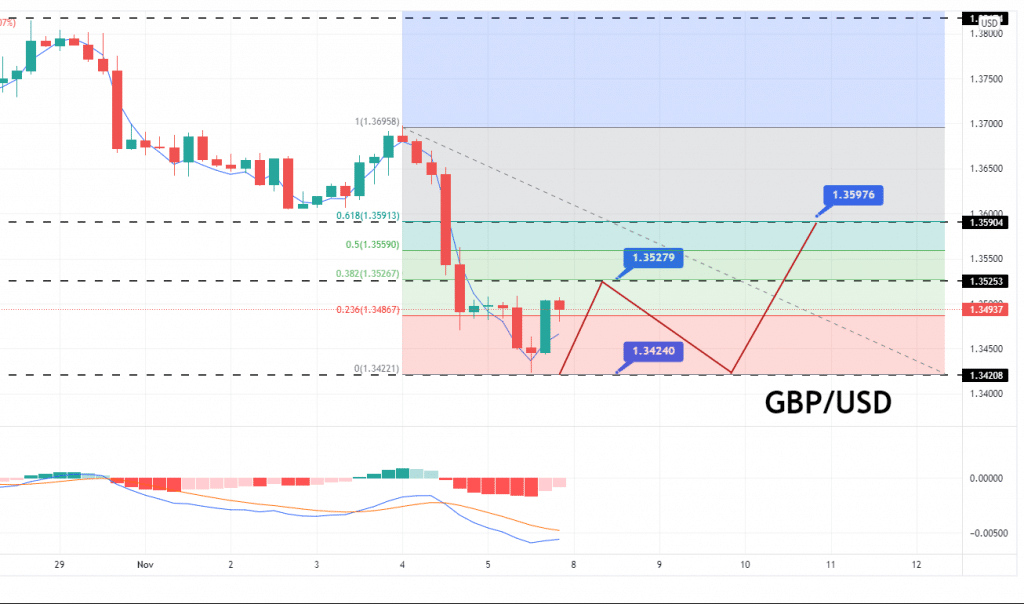GBP/USD Price Forecast: A Quick Review of FED, BOE and US Nonfarm Payroll
Please note that we are not authorised to provide any investment advice. The content on this page is for information purposes only.
- US Nonfarm Payroll report released on Friday suggested that the US created about 531K jobs during October.
- US Federal Reserve announced its monetary policy decision to slow down its bond purchases from November 2021 to November 2022.
- BoE decides to continue the existing UK QE program at a target stock of 875 billion pounds ($1.2 trillion).
The GBP/USD price forecast is likely to exhibit a slight bullish reversal as the pair has already entered the oversold zone. and investors may trigger profit-taking. The day before, GBP/USD closed at $1.3498 after setting a high of $1.3699 and a low of $1.3470. On Friday, the GBP/USD dropped massively to its lowest since October 1st after the release of the Bank of England’s monetary policy decision.
Another reason behind the steep fall in GBP/USD was the strength of the US dollar, as the DXY surged by more than 1%. It reached its highest since October 13th, at 94.47. The greenback was stronger across the market amid the better-than-expected jobs report for the day.
Refer to our trading guides to enhance your forex trading skills.
US nonfarm payroll figures dragged GBP/USD down to $1.3420.
The Nonfarm Payroll report released on Friday suggested that the US created about 531K jobs during October. It’s higher than the anticipated number. This job creation had the biggest jump in a single month since July. The job growth for the previous two months was not that impressive. Moreover, the US Labor Department reported about 194,000 more jobs created in October than in the previous month. In October, the unemployment rate dropped by 0.2% from the previous month, which also supported the US dollar.
The continued job creation by Americans is at a record pace. It has decreased the unemployment rate suggested an improvement in the efforts made to recover the lost jobs during the pandemic era. Hence, it reached the employment goals, which ultimately added strength to the US dollar and dragged GBP/USD to the downside.
On the data front, at 12:00 GMT, the Halifax HPI for October rose to 0.9% against the forecasted 0.7% and supported the US dollar, which added to further losses in GBP/USD. At 17:30 GMT, the average hourly earnings in the United States remained flat, with a 0.4% increase expected. The Non-Farm Employment Change increased to 531K from 455K expected, which boosted the US dollar and contributed to further losses in the GBP/USD. In October, the unemployment rate fell to 4.6% against the anticipated 4.7% and supported the US dollar, dragging GBP/USD further to the downside.
US Federal Reserve announced its monetary policy.
Recently, the US Federal Reserve announced its monetary policy decision to slow down its bond purchases from November 2021 to November 2022 to curb the effects of high inflation at a time when millions of employees remain on the job market’s sidelines. This news has also supported the gains in the US dollar, which has also added pressure on the currency pair GBP/USD.
Bank of England announced its monetary policy.
On the flip side, the BoE (Bank of England) announced its monetary policy decision in which it held interest rates steady. It defied many investors’ expectations that it would become the first major central bank to hike interest rates following the coronavirus pandemic. Furthermore, the bank also decided to continue the existing UK government bond purchases program at a target stock of 875 billion pounds ($1.2 trillion).
The bank was expected to increase interest rates. However, it surprised analysts by keeping rates unchanged. BoE said that it needed more time to gauge how the end of the program that paid furloughed workers during the coronavirus pandemic would impact the nation’s job market. This betrayal of the BoE to market participants weighed on the British Pound. It ultimately dragged GBP/USD further to the downside.
GBP/USD price forecast – Daily technical levels
Support Resistance
1.3413 1.3642
1.3327 1.3785
1.3184 1.3870
Pivot Point: 1.3556

GBP/USD price forecast – A potential buy entry on oversold GBP
The GBP/USD currency pair traded with a strong selling bias and dropped to the 1.3493 level. On the lower side, the GBP/USD gains immediate support at 1.3422 and resistance at the 1.3527 level.
On the 4-hour timeframe, the GBP/USD has entered the oversold zone, as the RSI and MACD are both in the oversold zone. Therefore, the closing Doji candle above the 1.3420 level is suggested in the decision among sellers. Thus, a weakness in the selling trend may trigger a bullish bounce-off in the GBP/USD pair.
The GBP/USD pair may find immediate resistance at the 1.3530 level on the bullish side. The 38.2% Fibonacci retracement level extends this particular resistance level. Therefore, the bullish breakout of this level can extend the buying trend until the 50% and 61.8% Fibonacci retracement levels of 1.3559 and 1.3590, respectively.
On the bearish side, a break below the 1.3420 support level could extend the selling trend until the 1.3327 and 1.3184 levels. Let’s look for buy trades over 1.3420 until 1.3559 and 1.3590 in the coming week.
Stay tuned for more updates, and have a lovely weekend!





